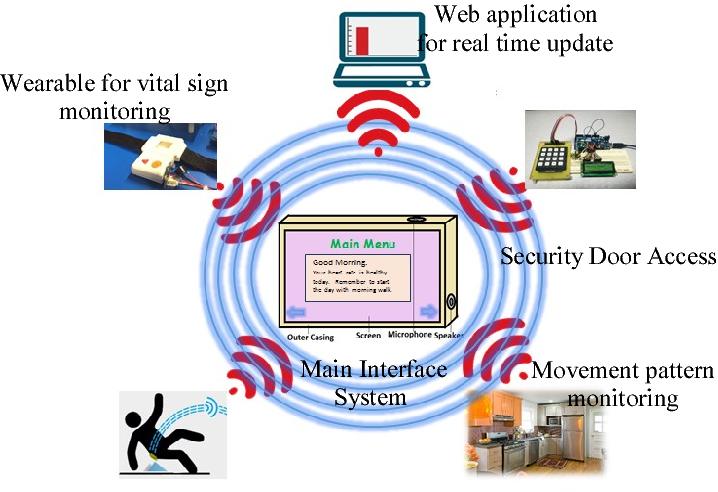Shelter-in-place orders related to the COVID-19 pandemic have exaggerated the social exclusion and loneliness of many elderly and vulnerable individuals, thereby increasing their chances of experiencing critical health complications. This trend—combined with societal shifts including reduced inter-generational living, greater geographical mobility, and less cohesive communities—has placed the elderly at heightened risk of being isolated and, consequently, in harm’s way.
Fortunately for senior citizens quarantined or living alone, technology can help detect and alert caregivers, healthcare professionals or family members to elderly persons’ changes in behavior—which can prevent serious issues.
Of the solutions available, the IoT is uniquely positioned to enable caregivers to support the well-being of those at risk when others cannot be at their side. By tracking key health indicators such as dehydration and malnutrition and behavioral changes like decreased mobility, IoT-enabled monitors reduce emergency hospital admissions and allow elders to stay in their homes longer safely.
Preventive fall detection
Falling, which becomes more prevalent with age, is the second leading cause of accidental or unintentional injury deaths worldwide. Therefore, actions for preventing falls must be taken both at home and in care facilities. Recording incidents, identifying risk factors (individual and environmental), and highlighting the preventive and corrective measures are critical steps in fall prevention, prediction, and detection. And they can all be accomplished with the IoT.
With conventional fall-detection technologies, a person must wear or carry the device and press a button upon falling. If the person is unwell but does not fall, nothing is reported, which is why it is important to monitor discomfort by other means, such as an algorithm that detects a change in the patient’s general wellbeing.
Using IoT sensors for this purpose, healthcare providers are able to track progress over longer periods of time (days or months) and determine whether an individual’s health is deteriorating, thereby placing them at future risk of falling. With this knowledge, caregivers can intervene and provide increased care before any injury occurs.
Keeping elders in their homes longer

When used in conjunction with tele-assistance services, IoT solutions can also help reassure families their loved ones are safe living on their own by transmitting critical information indicative of deteriorating health so that early warning signs don’t go unnoticed.
Companies such as SeniorAdom and Vitalbase have already developed remote assistance solutions based on IoT technology, including various motion detection sensors, geolocation pendants, and wrist bands. These solutions are designed to automatically detect any potential behavioral changes due to a fall, physical weakness, or cognitive deterioration (e.g., Alzheimer’s disease).
These innovative solutions make it possible to better protect elderly populations by anticipating risks and acting quickly in the event of an emergency. With a self-learning algorithm and an intelligent box wirelessly connected to sensors installed in the home, SeniorAdom can detect a potentially critical or abnormal situation and warn caregivers or relatives. SeniorAdom’s motion sensors and door open/close sensors learn the daily activities of the monitored individual to “get smart” on their everyday habits. As a result, the sensors can detect and send alerts about any changes in activities, which might indicate a problem.
How the sensors work
Operating on a 0G network—which is optimized to frequently transmit small amounts of information over a large distance—IoT-enabled sensors detect conditions and movement from connected devices, and never pick up personal information. Additionally, these devices consume minimal energy on a 0G network and therefore support communications at a very low cost. This means families can receive effective care without a hefty price tag.
Devices that run on other networks, like cellular, can also use a 0G network as a backup to ensure device users have constant supervision and those vulnerable individuals are able to communicate their health needs immediately. For example, Vitalbase’s Vibby OAK, an automatic fall detector worn on the wrist or neck, connects to a cellular mobile device but uses a 0G network when there is no primary connectivity, either because the user is not near a phone, or there’s no cellular network connectivity. At healthcare facilities, the device can interface with all existing nurse call systems to alert medical staff when an issue arises.
By optimizing automatic and intuitive fall-detection devices with the IoT, older adults can live more independently and maintain autonomy. The ability to remotely monitor seniors, receive alerts in case of emergencies, predict issues based on early warning signs, and intervene proactively offers peace of mind to both healthcare providers and families of senior citizens.
About Ajay Rane
Ajay Rane is the VP of Global Ecosystem Development at Sigfox, the initiator of the 0G network and the world’s leading IoT (Internet of Things) service provider. Its global network, available in 60 countries with 1 billion people covered, allows billions of devices to connect to the Internet, in a straightforward way, while consuming as little energy as possible.








